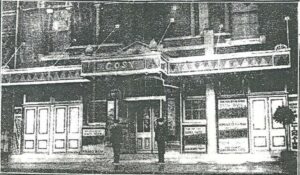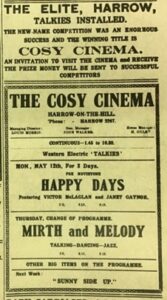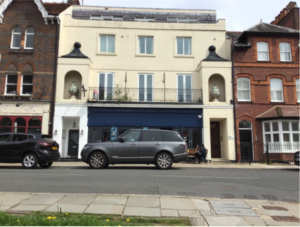Annette Kuhn
Until the 1920s, Harrow was little more than a village ten miles or so outside London; but by the end of 1910 the area already boasted three cinemas, two of which survived into the 1920s and beyond. In 1920, at the start of a population boom that was to rapidly transform a semi-rural area into a suburb of the metropolis, they were joined by two more: The Electric Cinema in Station Road and the Elite Picture House in Harrow-on-the Hill. In the mid 1920s the Electric Cinema became a live theatre, re-opening as the Harrow Coliseum. The Elite, however, continued as a picture house, and by the end of 1931 had undergone a makeover, the installation of a sound system being followed by a range of other improvements: “Machines and projectors have been brought up-to-date, enabling clear and perfect pictures to be shown…. A new canopy has been erected…and those who unfortunately have to wait in a queue can do so under dry conditions should the weather be adverse.… All the seats are constantly overhauled, thus ensuring perfect comfort for all….” Even the staff had been spruced up: “The girl attendants have been provided with new and attractive uniforms, while two uniformed page boys are in attendance in the vestibule to attend to the wants of patrons.” (Harrow Observer, 13 November 1931) Meanwhile, the cinema had acquired a new name: the aspirational-sounding Elite was now the more approachable Cosy.
In April 1930, the Elite’s management had posted an announcement on the front page of the local newspaper: a £50 prize was being offered for a new name: “Should more than one competitor submit the title used, the prize money will be divided.” (Harrow Observer, 25 April 1930) The result was revealed just a few weeks later: “The new name competition was an enormous success and the winning title is COSY CINEMA. An invitation to visit the cinema and receive the prize money will be sent to the successful competitors.” (Harrow Observer, 9 May 1930)
Interviewed in the 1990s, two of the Harrow participants in Cinema Culture in 1930s Britain recall the Elite’s renaming.
In the course of a series of interviews at her home, arranged by Harrow Public Library Housebound Readers’ Service, Nancy Carrington mentions the Elite/Cosy competition more than once. On 7 July 1995, for instance (NC-95-196AT001):
Nancy Carrington: …The Cosy Cinema. On the Hill. And my niece named that. She got five shillings in the old money.
Interviewer: Really!?
NC: For naming that cinema. She had to guess. It was a–
Sue Nicholls [Housebound Readers’ Service]: She had to guess what, Nancy?
NC: Guess the name of the cinema. And they chose the Cosy.
SN: Yes.
NC: Obviously. So she got the money for it.
Int: Right.
NC: She chose the Cosy.
Mrs Carrington’s niece’s five-shilling win suggests that the £50 pound prize had been divided between two hundred successful competitors.
Olga Scowen (OS-95-190AT001, 6 July 1995) also hints that the Cosy was actually far from cosy: “…The Cosy on the Hill. It was called the Elite at one time. They had a competition for somebody to suggest a name. And somebody suggested ‘Cosy’. Well I would never have called it that.”
As a unique selling point another of the Cosy’s innovations, “the luxurious Cosy coach…which runs regularly at intervals of a quarter-of-an-hour to convey patrons to the top of the hill” (Harrow Observer, 13 November 1931), is especially memorable. At a time when there was little or no public transport in the area, the Cosy’s shuttle-bus service spared filmgoers the energy-sapping trek up Harrow Hill to get to the cinema:
Olga Scowen: And erm, so anyway, when you wanted to go to the Cosy Cinema, you either had to walk or go on this little bus. And when we walked it was pretty steep up the last bit. And I can remember my sister pushing my mother–
Interviewer: [laughs]
OS: To get her up the hill. I mean we were that keen to go to the cinema that we’d do that. (OS-95-190AT001, 6 July 1995)
The bus is remembered as offering a door-to-door service:
Nancy Carrington: [The bus] … used to come out of the Cosy cinema, all the way round Harrow, and all the way. Right the way round till they got down here and then they used to drop us off practically at our houses. (NC-95-196AT002, 25 July 1995)
And its circular route is keenly, if effortfully, recollected:
Ashley Bird: And I don’t know whether anybody told you, erm, when they changed it to the Cosy, they used to have a bus that served it only.
Interviewer: Really?
AB: It used to come down from the cinema, down Roxeth Hill, into what they call Roxeth Corner. Erm, and it used to pick up people there, come on down into Harrow in [pause 2 seconds] College Road now, pick up people there. And, [pause 2 seconds] then go round, and stop outside the posh cinema, [laughs] in Harrow, the Coliseum, which is now a Gateway. And as kids we always, that was always very posh. You didn’t go there unless you were rich.
Int: [laughs]
AB: This little bus used to stop outside, pinch customers, from there, take them up the Hill.
Int: Really? So a door-to-door service?
AB: That’s right.
Int: Mhm.
AB: Of course, people used to come out of work erm, Friday evenings, and do it, you know.
Int: So was that all included in the price of your ticket?
AB: Eh, it was a free bus, yes. (AB-95-198AT001, 12 July 1995)
– – – – – – – – – – – – – – – – – – – – – – – – – – –
Gwen Curnick: And that one, that one that was up on a hill. Eh, they used to run a free bus service.
Interviewer: Really?
GC: Yes. Erm, I don’t know whether you can remember just where it went but it, it —
Fred Curnick: It came down [pause 2 seconds] along the High Road, down Roxeth Hill, then along [pause 2 seconds] Lower Road, isn’t it?
GC: Yes.
FC: Along Lower Road, Bessborough Road to Roxborough Bridge, over Roxborough Bridge, down, erm, [pause 3 seconds] that one’s College Road, isn’t it?
GC: College Road, yes.
FC: To the foot of College Road, then it turned right, and actually went in front of the Coliseum.
GC: Coliseum. Yes, that’s right.
FC: Erm, and then back up the Hill, up Peterborough Road.
GC: Yeah.
FC: Up to the top of the Hill and along the High Road again to the cinema.
Int: Ah.
FC: And eh, it done that [pause 3 seconds] evening, didn’t it? It wasn’t, it, it kept going round like that and you could get on it anywhere and go up to the Hill or you could come down. (GC-95-191AT001, 5 July 1995)
Sadly, there appears to be no photograph of the Cosy bus in existence. In 1934 the Cosy changed its name once again, becoming the Carlton, which closed in September 1937 under something of a cloud (Harrow Observer and Gazette, 4 August 1939). Today, the Elite, the Cosy, the Cosy bus and the Carlton are slipping from living memory into history, the only trace of their former existence being the name of the building that now occupies their site on High Street, Harrow-on-the-Hill: Carlton House.
_________________________________________________________________________
Materials from the Harrow local press are reproduced courtesy of Headstone Manor and Museum. © London Borough of Harrow.
The interviews referred to can be accessed as both audio and transcript via the CMDA website. These can also be consulted in physical form in the Cinema Memory Archive (CMA) at Lancaster University, by appointment with Special Collections.
Other relevant CMA assets include:
- Elizabeth Cooper and David Bednall, Pinner Streets Yesterday and Today. 1976. Pamphlet. AV-95-202PM002.
- Arthur Dark, From Rural Middlesex to London Borough: The Growth and Development of Harrow Illustrated with Maps. Harrow, London Borough of Harrow, 1981. Book. AV-95-202BK001.
- D.A. Pickrill, ‘When film fans were spoiled for choice’, Harrow and Wembley Independent, 31 December 1980. Photocopy (PR-CMDA-CM-20001-RM-00021-000-00001).
- P.J. Snell, A Pinner Miscellany. 1980. Pamphlet. AV-95-202PM001.
- Harrow Coliseum in the mid 1920s. Postcard. VB-96-002PC012.
- Rayners Lane c1928. Postcard. VB-96-002PC007.
If you wish to cite and/or re-use any of these materials, please consult the CMDA website for information on copyright and using the materials from the collection and for a citation referencing guide


